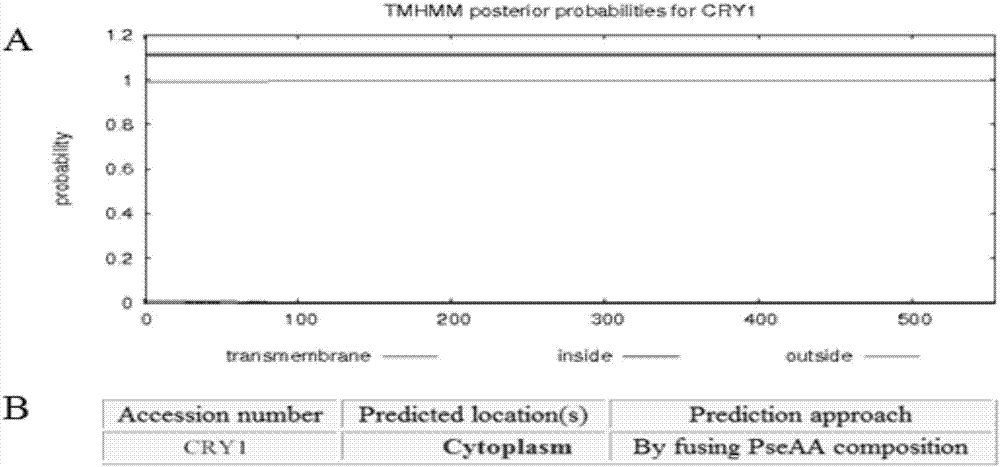Method, primer and kit for detecting blue light phototaxis of aphids
A technology of phototaxis and aphids, applied in the field of agricultural biology, can solve problems such as high technical requirements, unsatisfactory, difficult to operate, etc., and achieve the effect of avoiding heavy workload, high accuracy, and improving efficiency
- Summary
- Abstract
- Description
- Claims
- Application Information
AI Technical Summary
Problems solved by technology
Method used
Image
Examples
Embodiment 1
[0052] Cloning of opsin gene CRY1 from rape aphids (mainly Myzus persicae).
[0053] 1. Aphid total RNA extraction and cDNA reverse transcription
[0054] Use Trizol reagent to extract the total RNA of rape aphids, and the specific steps are as follows: (1) Take about 50 mg of the frozen sample in an ultra-low temperature refrigerator, pour it into a mortar, and grind it thoroughly. The powder was transferred to a clean centrifuge tube with 1 mL of Trizol reagent, shaken vigorously, then left at room temperature for 10 min, centrifuged at 12000 rpm at 4°C for 10 min, and the supernatant was transferred to a new centrifuge tube. (2) Add 0.2mL chloroform, shake for 30s, and place at room temperature for 10min. Centrifuge at 12000rpm at 4°C for 10min. (3) Take the upper aqueous phase to a new centrifuge tube, add 400 μL of isopropanol, mix well, place at room temperature for 10 minutes, centrifuge at 12,000 rpm at 4°C for 10 minutes, and discard the supernatant. (4) Add 1 mL o...
Embodiment 2
[0089] In order to facilitate detection and application, this embodiment provides a primer for detecting blue light phototaxis of rape aphids, which includes primers shown in Seq ID No.5-6.
[0090] Using the cDNA of the rape aphid provided in Example 1 as a template, and the sequence Seq ID No.5-6 as a primer, the full-length sequence of the rape aphid opsin gene CRY1 can be obtained by one-time PCR amplification, and the PCR reaction system is as follows:
[0091] wxya 2 o
13.6μL 10×Buffer 2.0 μL dNTP (2.5mM) 1.6μL cDNA 1.0 μL Upstream primer Seq ID No.5 (10μM) 0.8μL Downstream Primer Seq ID No.6 (10μM) 0.8μL Taq enzyme 0.2 μL overall system 20.0 μL
[0092] The conditions of the PCR amplification reaction were: pre-denaturation at 94°C for 5 minutes; 30 cycles at 94°C for 30s, 55°C for 30s, and 72°C for 30s; and extension at 72°C for 10 minutes.
[0093] After sequencing and comparative analysis, it was fo...
Embodiment 3
[0096] Bioinformatics Analysis and Discrimination of Opsin CRI of Rapeseed Aphid
[0097] 1. Analysis of the Conserved Domain of CRY1 Opsin in Rapeseed Aphid
[0098] The conserved structure analysis of the opsin sequence of rape aphid was completed by SMART (http: / / smart.embl-heidelberg.de / ). Using Smart analysis, the results showed that CRY1 opsin has DNA photolyase protein family and DNA photolyase FAD binding protein family conserved domains, but no binding site ( figure 2 ).
[0099] 2. Prediction of transmembrane structure and subcellular localization of CRY1 opsin in rape aphid
[0100] Using TMHMM Server v.2.0 to analyze the transmembrane region of the protein sequence (http: / / www.cbs.dtu.dk / services / TMHMM / ) to predict the transmembrane structure of the rape aphid opsin. The analysis showed that no transmembrane structure was found for the CRY1 opsin of the rape aphid, and the subcellular location was in the cytoplasm (such as image 3 As shown, in the figure: A: ...
PUM
 Login to View More
Login to View More Abstract
Description
Claims
Application Information
 Login to View More
Login to View More - R&D
- Intellectual Property
- Life Sciences
- Materials
- Tech Scout
- Unparalleled Data Quality
- Higher Quality Content
- 60% Fewer Hallucinations
Browse by: Latest US Patents, China's latest patents, Technical Efficacy Thesaurus, Application Domain, Technology Topic, Popular Technical Reports.
© 2025 PatSnap. All rights reserved.Legal|Privacy policy|Modern Slavery Act Transparency Statement|Sitemap|About US| Contact US: help@patsnap.com



